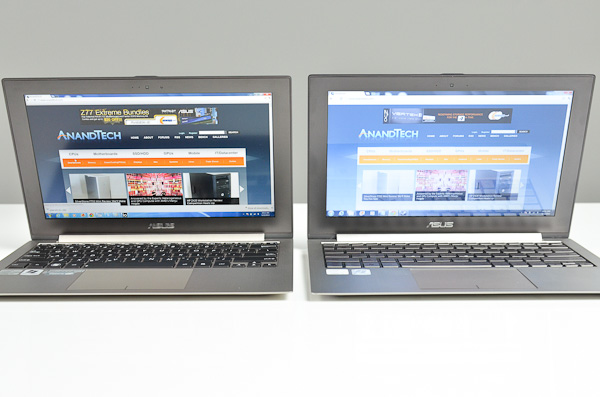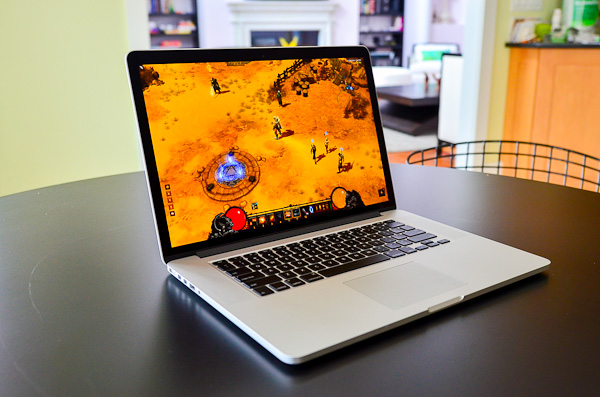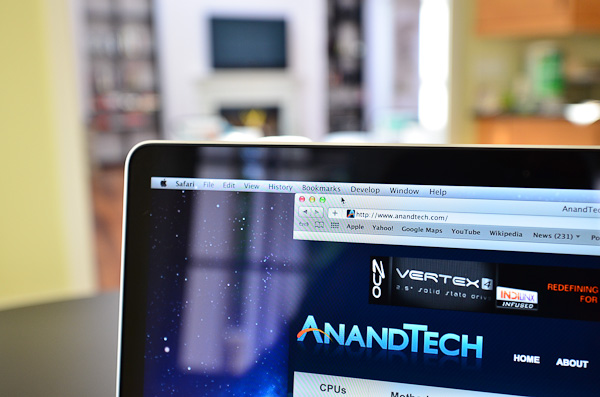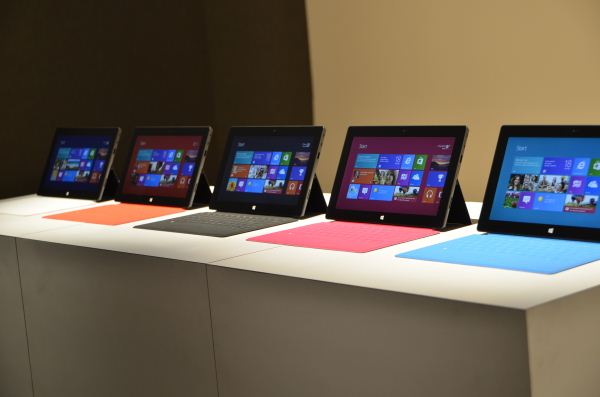The next-gen MacBook Pro with Retina Display Review
by Anand Lal Shimpi on June 23, 2012 4:14 AM EST- Posted in
- Mac
- Apple
- MacBook Pro
- Laptops
- Notebooks
Final Words
Apple has done an incredible job with the next-gen MacBook Pro. It brings a level of portability to the 15-inch chassis that we’ve never seen before from Apple, all while getting a good handle on some of the thermal and noise issues from last year’s model. If you’re like me and have to lug your 15-inch MBP around, the improvements in portability alone are worth the upgrade. But a lighter chassis is hardly all Apple is relying on to sell this system.
The internals are easily the best collection of parts Apple has ever assembled. Ivy Bridge and Kepler are natural fits, but shipping the machine with 8GB of memory by default is a much appreciated gesture especially considering its un-upgradeable nature. For the first time in Apple’s history of shipping NAND flash based storage in Macs, I actually have no complaints about the controller choice in the rMBP. Samsung’s PM830 (or the consumer, SSD 830, version) is what I’ve been recommending to Mac users for much of the past year. It’s still possible that you’ll end up with a non-Samsung controller, and I don’t yet know whether or not that’s a bad thing, but this is at least progress.
The connectivity story on the rMBP is near perfect. The pair of Thunderbolt ports allows extra flexibility as well as the ability to drive more bandwidth to external IO than any prior portable Mac. The Thunderbolt teething issues still remain unfortunately, but it looks like that’s going to require at least a partial act of Intel to rectify. USB 3.0 is a welcome addition to the Mac family. It took both Apple and Intel far too long to get to this point, but I’m glad it’s here.
All of this is really just wrapping however, as the real gift is the MacBook Pro’s first Retina Display. It’s easily the most beautiful display I’ve had the opportunity of using. Even more impressive to me than the iPad’s Retina Display, and enough to make me actually want to use the Mac as a portable when at home rather than tethered to an external panel. The added portability of the chassis likely contributes to that fact though.
The credit Apple deserves for the display extends beyond simply pushing LG to get a panel out on time and in large enough quantities. There’s a tremendous amount of software work that Apple put into making the Retina experience work under OS X. The OS and several key applications have been updated to properly support the MacBook Pro’s Retina Display, and things can only get better from here. Mountain Lion will improve performance and I would expect at least a few key app updates over the next year to bring increased Retina awareness.
There’s also the behind the scenes work Apple put in to make all of this happen. The pressure on the GPU vendors, as well as taking matters into its own hands with writing scaling and filtering routines to deliver a good experience are all noteworthy.
It’s because all of this that I’m doing something I’ve never done before in an Apple review. We rarely give out Editor’s Choice awards at AnandTech, and I’m quite possibly the stingiest purveyor of them. I feel that being overly generous with awards diminishes their value. In this case, all of the effort Apple has put into bringing a Retina Display to the MacBook Pro is deserving of one.
 I’m giving the MacBook Pro with Retina Display our bronze Editor’s Choice award. Making it the first Mac to ever receive one. It would have been a silver had the software story been even stronger (iWork, Mountain Lion, Office and Photoshop being ready at launch would have been a feat worth rewarding). And it would have been a gold had Apple been able to deliver all of that but without sacrificing end-user upgradability. Which brings me to my final point.
I’m giving the MacBook Pro with Retina Display our bronze Editor’s Choice award. Making it the first Mac to ever receive one. It would have been a silver had the software story been even stronger (iWork, Mountain Lion, Office and Photoshop being ready at launch would have been a feat worth rewarding). And it would have been a gold had Apple been able to deliver all of that but without sacrificing end-user upgradability. Which brings me to my final point.
I accept the fact that current mobile memory and storage form factors preclude the creation of the thinnest and lightest form factors. But I would like to see Apple push for the creation of industry standard storage and memory form factors that wouldn’t hinder the design of notebooks like the Retina Display equipped Macbook Pro. As Apple has already demonstrated that it has significant pull with component vendors, this should be possible. The motivation behind doing so is no different from the motivation driving the use of Retina Displays: for the betterment of the end user experience.
Sidebar: Impacting the Rest of the Industry

ASUS Zenbook Prime (left) vs. Zenbook (right)
Apple’s impact on the industry has already been felt. The threat of Apple bringing Retina Displays to its entire lineup forced ASUS’ hand and gave us 1080p IPS panels in the new Zenbook Primes. This will undoubtedly continue. In the early days Apple simply raised the bar for a focus on industrial design. Apple’s influence quickly expanded to touch everything from packaging to trackpads. We’re now seeing PC OEMs focus far more on experience than they ever have before. Apple isn’t the only one to thank for this, but the company is a significant factor.
The fact of the matter is the days of blaming a lack of innovation on cost or the inflexibility of one’s suppliers are over. In fact, those days are long gone. Today the MacBook Pro with Retina Display exists at a very high starting price, but make no mistake, it won’t remain there indefinitely. Apple introduced this model as the next-generation MacBook Pro because it truly is a preview of what’s to come. Maybe next year’s model won’t be any cheaper, but the one after that definitely will be. Apple has a healthy obsession with high quality displays and it will put its might behind panel suppliers until it can put forth a lineup of top to bottom Retina Displays. There’s no doubt in my mind that within the next 12 - 24 months Apple will introduce an external 4K Retina Display. Whether you love, hate or are indifferent about Apple and its products, its impact on the industry is tangible. PC OEMs now care about display quality and keyboard feel. They care about trackpads and design. There’s only one motivator in this industry stronger than Moore’s Law: experience, and the PC OEMs finally care about that too.
Apple’s success hasn’t been because it is a vertically integrated company. On the contrary, everything Apple has done Acer, Dell, HP, Intel, NVIDIA and Microsoft could have done together. Apple is successful because its competitors have all been selfishly focused on themselves rather than all coming together to build better computers. Based on my conversations with Intel and some of the OEMs at Computex earlier this month, the wake up call has been heard. Intel seems quite motivated to help its OEM partners do better. It is a bit troubling for the ecosystem that Microsoft is throwing its hat into the ring as a competitor - especially as it was Microsoft's inaction on the software side that really hurt the PC OEMs over the past several years.
For years we’ve been pushing OEMs to focus on better displays, and for years we were given cost and customers-don’t-care as excuses for why we don’t get them. That’s all starting to change.














471 Comments
View All Comments
EnzoFX - Saturday, June 23, 2012 - link
Tell MS to buy them then. Can you really not see how Apple forcing this, makes others want to compete?UberApfel - Saturday, June 23, 2012 - link
You must be new to economics.ciparis - Saturday, June 23, 2012 - link
Because there were so many 2800-class displays on notebooks before Apple introduced them. Or desktop for that matter.Innovating while securing your own future production capacities, even if it means others will have a hard time copying you, is a perfectly reasonable business decision.
Taft12 - Monday, June 25, 2012 - link
Perhaps they really did buy 'em all, but anticompetitive would be preventing any more factories capable of producing high-resolution displays from coming into existence. Now *THAT* would be impressive!OCedHrt - Saturday, June 23, 2012 - link
Already exists on PC. And in 2012 Apple introduces DPI scaling? Windows had this in XP if not earlier.Akdor 1154 - Saturday, June 23, 2012 - link
yes, and it STILL isn't up to par, even with Windows 7. You can see on the shots in the review how well it performs - titlebars are too small, icons are nastily pixellated (as it can only go up to 1.5x, not a round 2x), and third party support is patchy at best. (As an aside, I would be very interested in an article on the differences on high-res drawing APIs between Windows and Mac OS. )Microsoft got there first with a half-done approach, Apple polished it.
N.B. I'm a happy Windows user, but this particular piece of tech is making me quite jealous..
internetf1fan - Saturday, June 23, 2012 - link
" (as it can only go up to 1.5x, not a round 2x)"Anand is wrong. They looked at only the preset options given by Windows which are 100%, 125% and 150%. Had they bothered to look at the other options, they would have noticed that you can easily set the custom DPI at 200% to get a x2 behavior you want. This review is seriously shoddy.
fmcjw - Saturday, June 23, 2012 - link
Yes, never seen Anand totally gushing like this. It's as if he can justify all the non-upgradeable design quirks and incompatibility with existing applications, simply by gazing at the hi-res display. I don't think many can distinguish pixels on a 13" FullHD, or even an 11" 1366x768 at normal viewing distances.In his bias and self-deception he glossed over flaws and uses the resolution as the way out of every flaw. Isn't the old matte display better than the new fancy "low-gloss" glossy display? Anand failed to look into the battery type integrated, whether it's one of the 1000-cycle packs. More unforgivably, he glossed over the low color gamut aspect, omitting a common sRGB comparison table.
Until I see a demo unit, I'll stick to the view that this is just a gimmick to lock in users by favoring proprietary, Retina-optimized applications, while 95% of applications are better off in FullHD/1920x1200 on a laptop.
This review is proof that even one of the most professional reviewers can be blinded by his own self-deception and pretty looks.
themossie - Saturday, June 23, 2012 - link
What proprietary, Retina-optimized applications? You're already running Mac OS X, it's not gonna get any more proprietary :-)The maximum selectable resolution on the MBP Retina Display -is- 1920x1200. When you select 1920x1200, it renders at 3840x2400 and downscales the image to 2880x1800.
Can easily distinguish pixels on an 11" 768p machine - I use one on a daily basis. 13" 1080p from normal viewing distance is much harder to distinguish.
damianrobertjones - Sunday, June 24, 2012 - link
"New super resolutions are coming to notebook/ laptop computers. Thanks to Apple and their forward looking business sense. Wonder when it comes to PCs..... with Windows 8?"Pointless on smaller screens.